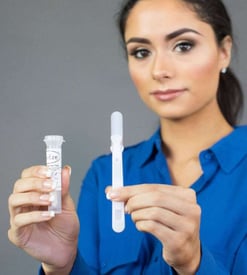Marijuana Impairment and Drug Testing
Which drug testing method—urine, oral fluid or hair—is best at detecting marijuana and establishing...

Now is the time to prepare: avoid exorbitant unexpected costs due to absenteeism, workplace accidents, and worker compensation claims.
This article summarizes the high-impact webinar we recently held with renowned drug testing expert and industry veteran, Bill Current. Bill is the President and Founder of Current Consulting Group and author of 9 books, including "Why Drug Testing: Updated and Expanded for 2020".
Premise #1 — Substance abuse is on the rise and not likely to come down in the foreseeable future.
Premise #2 — More than 41 million people filed “first-time” unemployment claims through the end of May.
Premise #3 — These same 41+ million people will be flooding the job market as the pandemic comes under control and the economy begins to reopen.
According to SAMHSA (Substance Abuse and Mental Health Services Administration), substance abuse in the U.S. before the economic shutdown (2018 National Survey on Drug Use and Health):
So, as the economy recovers, job candidates from this age group will be plentiful.
Alcohol use is on the rise. There is evidence that the PTSD-related substance abuse trend has already started with the economic shutdown. The Associated Press recently reported:
The eCommerce platform Jane Technologies experienced a 142% increase of new online buyers during the first months of 2020. There are similar reports of significant usage increase in the states of California, Florida, and Michigan. (For more information, listen to our webinar “How to Prepare Now for a Drug-free Post-Pandemic Workplace” held June 4.)
53.2 million Americans aged 12 and older were illicit drug users in 2018. If substance use increases 30% during the pandemic like it did after 9/11, there are or soon will be as many as 70 million illicit drug users in the U.S.
Like usual, businesses will have to weigh the risk of their workplace safety versus the costs to administer and deploy a drug testing program.
The average cost of an employee with an untreated substance abuse disorder is:
For "all industries", this doesn’t include the cost of excess healthcare expenses, absenteeism, and employee turnover.
For "safety-sensitive" industries, additional costs include risk of injury or death, workers compensation claims, damaged machinery, and downtime at the facility to leading to lost work.
Want to calculate the cost of drug abuse to your company? Try out the DISA Calculator.
Does a business care about what happens while its employees are working in their home?
33% of Americans admit to being more likely to drink during working hours while at home. To check out the percentage of workers who have admitted to drinking during working hours in your state, click here.
Businesses must weigh the impact drinking and other drug use has on its workforce. The possibility and likelihood of lost productivity and mistakes increases with the consumption of alcohol and the use of drugs. Studies show that workers drink more frequently while working from the home office and that the possibility of increased substance abuse during times of crisis is a serious consideration.
Companies can conduct drug testing in the pre-employment process and random drug testing on its existing employee population.
Drug testing and random drug testing are proven deterrents. Drug users don't like pre-employment drug testing. According to a SAMHSA survey:
Marijuana is approved for recreational and/or medicinal use in 34 states. Does it even make sense to test for drugs anymore?
A business has to weigh a number of factors such as federal law, creating a safe workplace, safety-sensitive and regulated positions, availability of workers, brand image, ability to attract and retain employees, etc. among others.
However, recent trends in law (Nevada, New York City) should not alone be considered a deterrent to a company's willingness to conduct a drug testing program. Are there legal considerations for companies to follow? Yes. Do these legal provisions in and of themselves negate a company’s ability to conduct pre-employment and random drug testing altogether? No.
Today’s environment can present challenges to conducting a drug test. Collection facilities may be closed, have reduced hours of operation, or may be unable to offer urine collections at this time. Moreover, candidates and employees may be reluctant to visit these facilities.

Recently endorsed by the federal government, lab-based oral fluid testing eliminates some of the challenges described.
Oral fluid collections, for example, do not require the use of an off-site collection facility. An on-site oral fluid collection can be conducted by a trained employee.
In a typical oral fluid collection, the donor and collector are in proximity with one another during the entire collection process, making every collection fully observed. However, because the collection is donor-driven, the donor and collector can easily maintain six feet of distance between themselves per guidance from the Centers for Disease Control and Prevention (CDC). The collector also can wear a protective mask and gloves.
The “work-from-home” environment has created an evolution of the oral fluid collection testing. Some companies have opted for a remote video-observed collection conducted via their virtual platform of choice e.g. Zoom, Skype, or FaceTime.
A trained employee observes the donor conduct the test per instructions given by the observer. Care should be taken in the shipping process, both to and from, to ensure a proper collection is made. Companies must also work through the details of the collection process. Overall, it’s fairly straight forward to procure the oral fluid test required and to conduct the test once the appropriate procedure has been developed.
Additionally, drugs are usually detectable in an oral fluid sample within minutes after usage. This makes oral fluid testing ideal for detecting recent use, which may be of heightened concern for safety-sensitive occupations during COVID-19.
Urine and Oral Fluid Collection Side-by-Side Comparison
| Urine Collection | Oral Fluid Collection |
| Collection sites closing or cutting hours |
Off-site collection services unnecessary |
| Close proximity of individuals in restrooms |
While observed, the donor completes the collection process independently |
| Sanitation concerns with heavily used restrooms |
Allows the test administrator to remain at a safe distance (CDC recommends 6 feet) |
| Inability to adhere to CDC recommended 6 feet of separation from others |
While wearing protective gloves, the donor seals the collection vial and prepares sample for shipment |
| Additional time requirements to prepare each collection while assuring adherence to safe collection procedures |
Removes the need for sanitized restrooms and same gender collectors |
Now is a good time to review and update your drug testing policy. It’s also a good time to conduct training for members of your organization who are involved in the drug testing process.
Orange Tree offers a full suite of drug testing solutions including the administration of a random drug testing program. We can help you consider and assess how these different solutions align with your business goals and policy.
Orange Tree also offers an easy-to-use and popular single order background and drug testing experience for you and your candidates. The process begins with a text and allows the candidate to schedule a testing location convenient for them. Our mobile friendly CandidateConnect® platform also reduces turnaround time by a day.
Orange Tree's solution enables the best possiblecandidate experience while allowing you to do your work instead of handling the logistics related of the drug test. All steps in the process are annotated in our ClientConnectTM portal so you are kept informed every step of the way.